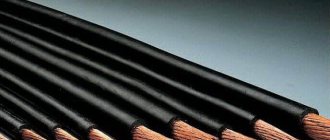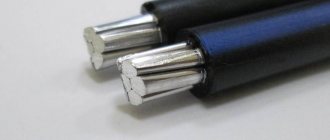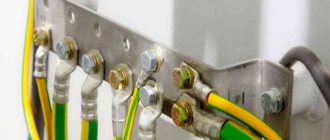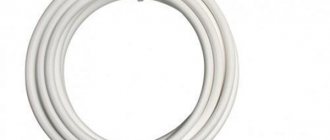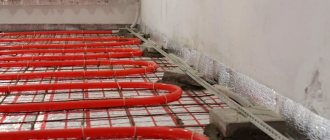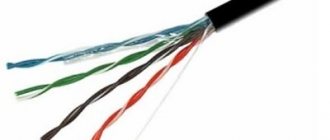What you need to know about the heating element of a cable heated floor
The electric cable is the basic heating element of a cable system designed for underfloor heating. When purchasing equipment, you should first find out what its power per unit length is. Various manufacturers and brands offer their customers electrical cables with a specific heat release level ranging from 17 W/m to 21 W/m. Even a minimal excess of these indicators is considered not only extremely undesirable, but also unsafe. In a cable floor heating system, two types of cable are usually used: self-regulating or resistive.
Features of a self-regulating cable
The self-regulating cable is designed in such a way that the level of useful heat it generates changes along with the temperature in the room in which the heating equipment is located. Such heated floors can be installed directly under the floor covering, since they are absolutely not afraid of local overheating.
Specifics and design of resistive cable
Resistive heating cables are used in the bulk of electric heated floors. It is suitable for different types of flooring and is classified according to the following parameters:
1. Configuration:
- single-core ones have 1 metal heating core (made of brass, galvanized steel, nichrome or other high-strength material) and 2 mounting leads located at both ends of the cable. They are equipped with internal insulation and a special screen that protects the structure from all kinds of mechanical damage and reduces the level of electromagnetic radiation;
- twin-core ones consist of 2 cores (heating+return or heating+heating), one mounting terminal and a convenient end coupling. The top is covered with a metal braid and an active protective screen. Their installation scheme is much simpler than that of single-core ones, but the cost is slightly higher.
2. Thickness:
- thin - from 2 to 3 mm - do not require screed laying and can be easily installed even in a layer of the most common tile adhesive;
- thick ones - from 4 to 5 mm - for correct operation they must be filled with concrete-cement mortar (screed).
3. Total linear power per linear meter:
- active heating cable - 18–22 W/rm. - has a high efficiency rate and requires intense heat transfer. A layer of durable heat-intensive material with a height of at least 3 centimeters must be placed above it. With this installation option, the necessary heat generated by the cable is removed, and the system does not overheat even during constant operation;
- moderate heating cable - 8–12 W/rm. — warms up slowly and smoothly. Suitable for “dry” installation, for installation without the use of cement-concrete screed and for installation under floor coverings with low thermal conductivity (laminate, carpet, linoleum, parquet, etc.).
Both types of electrical cable operate stably, for a long time and reliably. If the system is installed and operated in strict accordance with the rules and regulations stated by the manufacturer, the service life of the heating cable is at least 50 years.
The heating cable for underfloor heating systems is sold on a spool, in the form of separate sections or special mats (rolls). The mats consist of a thermal conductor, which is laid in a snake pattern and reinforced on a fiberglass mesh base. Such material can be easily cut into fragments, of course, without disturbing the integrity of the electrical cable, and covered with it on planes of any size and shape.
How to make a water heated floor under tiles?
The water floor under the tiles is installed in the same order as the electric one. However, heating with water and electricity has different physical laws. With an electric floor, the temperature of the cable along the entire length is the same, but with a water floor, everything is different. The highest temperature mark will be noticed at the point where water enters the heating system from the boiler. During circulation, the water loses temperature and arrives at the boiler in a cooled state. Thus, the coolant has different temperature indicators at the outlet and inlet.
Improper installation of a hydronic floor will significantly reduce the operating efficiency of the entire heating system. Therefore, before installing it yourself, read the technological diagram and instructions.
There are two options for laying water floors:
- concrete installation system;
- floor installation system - wooden or polystyrene foam.
The first one has a low price, which makes it very popular among consumers. The operating procedure is the same as for an electric heated floor using heating mats. Water floor pipes, unlike electrical cables, are not afraid of overheating. However, their installation is carried out in strict accordance with the sequence, without any fractures or bends. To do this, use reinforcement with cells of about 15 cm and wire with a diameter of 5 mm. These dimensions are needed to support the weight of a water-heated floor.
Installation steps may be different, since the water pipes do not overheat, but no more than 30-40 cm; if the distance is greater, the efficiency of the entire system will decrease. In addition, areas with low temperatures may appear on the floor. The pipes are secured with dowels and clamps.
The pipeline for a water heating system can be laid in different ways:
- spiral;
- spirally, shifting the center;
- snake (parallel);
- meander (double snake).
When choosing any method, consider the following:
- room dimensions;
- heat loss of the room;
- number of windows, doors, external walls;
- floor.
About installation
In a place where the level of heat loss is high, lay pipes with the hottest coolants. The length of the pipe from inlet to outlet should be up to 100 m. Otherwise, the quality of the heated floors will suffer. To calculate the required number of pipes, take the following construction standard as a basis: per 1 sq. m area will need 6-7 m of pipe.
Lead the return and supply ends of the pipe into a manifold cabinet, which must be mounted in a niche on the wall. It can be done openly. The choice of cabinet placement option depends on your capabilities and desires. Pipes are brought into it, to which the main heating circuit is connected, a valve is installed to shut off the coolants, and a temperature regulator is installed. You can also regulate the temperature with an electronic valve, which responds to a signal from a temperature sensor.
Before pouring the screed, check the functionality of the system to prevent possible coolant leaks. The floor installation system does not require the creation of a sand-cement screed. This helps to quickly bring the floors into service and reduce the load on the supporting structure of the room, since a water-based flooring weighs much less than a concrete one.
Which cable is best to choose for underfloor heating: characteristics
When choosing, it is important to consider the following nuances:
- The price of the product should not be very low, because such a cable can quickly fail. Therefore, it is better not to skimp, but to take a trusted manufacturer that will last longer.
- Consider installation costs. The resistive option requires additional investment in the purchase of a temperature controller. When choosing a self-regulating option, purchasing such a regulator is not required. For a large room, it is recommended to select a resistive type wire. If in the future a rug will be placed on the floor, then it is worth purchasing a self-regulating wire to prevent local overheating.
- To decide on a cable for a heated floor, it is worth considering the functionality that will be assigned to it. For direct heating, a two-core or single-core cable or a heat mat is suitable. Before installing the floor covering, such products are laid in a thin layer of screed. This approach allows you to warm up the room in a short time. If the function is to accumulate heat, then it is worth using a self-regulating or two-core resistive cable. In this case, the system can cope with heating concrete with a thickness of 5 cm.
When choosing a cable, it is important to take into account many nuances, because this is the only way to achieve high-quality system operation.
Two-core
One core is used to generate heat, the second to provide electric current. The installation process does not require installing the two ends of the cable at one point. The two-core model has a return core and an additional insulating coating, which guarantees safety during cable operation. The main difference between a two-core and a single-core wire is that the latter will have to be returned to the thermostat.
Single core cables
Provides heat transfer along the entire length. The disadvantage of such a cable is a possible overheating point. Some areas of the flooring will be too hot. When installing, you must ensure that both ends are at the same point.
Laying wires in a screed under heated floors with your own hands
Installation of the heating cable is carried out in several stages:
- A cement-sand screed with a thickness of at least 3 cm is poured. To lay the wire that will pass to the thermostat, you will have to cut a channel, the diameter of which is within 2 cm.
- Installation of a heat-reflecting substrate layer.
- Installation of reinforcing mesh on which the cable is fixed. If you do not use a mesh, you will have to install tape. The product should not be placed under furniture.
- The wire is being laid.
- The heat sink is installed in a special corrugated tube and placed in a groove.
- A cement screed, 4 cm thick, is poured. Ohmic resistance and insulation resistance are indicators that should be established to determine the performance of the cable after pouring. Laying the floor covering is carried out after the solution has completely dried, which will not happen earlier than a month.
When carrying out installation work, it is important to follow the following installation rules:
- Avoid loops in the cable. Individual sections should not intersect.
- According to safety rules, the location of heating systems from metal structures should be 5 cm, from wooden structures - 3 cm, but from other heat sources - 50 cm.
- Follow the laying step, focusing on 6-10 outer diameters of the wire.
- The hot part of the wire must be in insulating material.
- When laying inside the screed, the cable pitch is 20 cm, when arranging a direct floor - 10 cm.
- The batteries are not connected directly to the network; a regulator is used for this.
- The thermostat is installed 50-150 cm from the floor.
- The use of twists is prohibited, connections only through special terminals.
- To avoid power surges, it is necessary to use circuit breakers.
Before carrying out installation work, everyone can study the presented videos on this topic on the Internet.
What wire gauge is needed?
The maximum current for thermostats is 16 A, the load is 3.5 kW. If the floor is connected to one thermostat and the total power of the system does not exceed 3.5 kW, then a pickup point with a cross-section of 1.5 mm2 is suitable for operation. If this figure is higher, then you should pay attention to models with a larger cross-section. So a model with a cross section of 2.5 mm2 can withstand a load of 25A.
The maximum current of the regulator should not be greater than the total current consumed. Otherwise, there is a risk that the thermostat will fail. Using an additional relay or another thermostat can solve the problem without replacing the wire.
If you still find it difficult to choose a section, it is recommended to pay attention to the data in the table.
Thermostats
Thermoregulator (thermostat) is a device designed to control the heating system. Allows each user to control the heating temperature level, reducing or increasing it at will.
In the modern market, accessories of this type are offered in a wide range by various brands. The cost of devices largely depends on the country of origin. The cheapest models are made by China; in the middle price segment, products from Belarusian and Russian enterprises predominate, and the highest prices are asked for products from Danish, Finnish and Swedish brands.
Another cost component is the type of thermoregulatory device. Simple and unpretentious devices with a minimal set of functions will cost the client significantly less than ultra-modern programmable models with an extensive package of capabilities and a memory base that allows you to set the desired heating mode for 3-7 days.
The third pricing factor is the management method. Today, mechanical, wireless, push-button and touch-sensitive thermostats are available for sale. The more complex and sophisticated the design of the device, the more money you will have to pay for it. You can find a mechanic for a fairly budget price, but a modern touch-screen version with the ability to program the system on/off several days in advance will cost a tidy sum.
Before purchasing a thermostat, the user must clearly decide which functions of the device will be used regularly and only then make a choice. There is no point in overpaying for unclaimed features.
Types of heating cables for “warm floors”
For electric floor heating systems, resistive type cables can be used (with traditional heating of the conductor when an electric current is passed through it) or semiconductor cables (the principle is somewhat different there).
Resistive heaters for “warm floors”
They, in turn, are divided into single- and double-wire (or single- and double-wire). And this difference, from the point of view of ease of installation of the system, is very serious.
Single wire heating cable is shown in the illustration below:
Diagram of a single-wire heating cable
1 - a wire (core) with a certain electrical resistance necessary for heating when passing an alternating current of 220 volts.
2 — heat-resistant PVC insulation of the conductor.
3 — shielding copper braiding of the cable.
4 — external general PVC insulation of the heating cable, resistant to the alkaline environment of the concrete screed.
5 - switching couplings in which the electrical connection of the connecting wire and the cold ends is made and insulated (item 6 ). The cable is single-core, so there are two such couplings, but one at each end.
7 — stripped ends of the wires for connection to the thermostat terminals. Two pieces - this is the conductor itself, for connecting to N or L, and the braid - for connecting to the PE grounding, if it is organized in a home network.
We recommend: Gas filters: types, design, purpose and features of choosing a gas filter
Now let’s immediately compare it with a two-wire analogue.
Despite all the similarities, the differences are still very serious
Let's just look at the differences:
1a - instead of one, the cable has two cores (two conductors). They both can be resistive, that is, they participate in heating. But there are cable models in which there is still only one heating core, and the second serves only for switching the circuit.
2a - more serious isolation. That is, first, each core is wrapped in its own heat-resistant PVC insulation, and then, before the copper braid, there is also a common layer.
5a - commutation coupling - there is only one, as well as one “cold end” (pos. 6a ). But at this end there are already three conductors (pos. 7a ) - for connection in the terminals to L, N and PE.
8 — the end sleeve is typical only for two-core cables. It closes an electrical circuit between two conductors, followed by reliable insulation of this node.
It is easy to understand that with equal electrical characteristics and the same required length of the heating cable, a two-wire cable is much more convenient to install. Proof of this is the following diagram:
The difference is in the layout of a single-core (left) and two-core heating cable.
Exactly identical rooms and cable laying pattern. But with a single-core version (on the left, on a greenish background), a prerequisite is that both ends of the cable must converge in one section - to connect to the thermostat. This can significantly complicate installation, also taking into account the fact that cable crossings on the floor are unacceptable. The example, let’s say, is not particularly illustrative, with a very simple circuit, but there are also very complex configurations, and you have to “rack your brain” how to meet all these requirements.
It’s a different matter - a two-wire one, suitable for the thermostat only at one end. The second end with the coupling may be “lost” somewhere in the vastness of the premises - this is completely unimportant, since the electrical circuit is still closed.
heating cable for underfloor heating Expert opinion Afanasyev E.V. Editor-in-Chief of the project pol-exp.com
Engineer. There are many ready-made kits on sale, in which the cables (usually two-core) are already laid in a snake pattern on a mesh base. This simplifies the installation of the system, and in addition, it allows you to lay the floor with ceramic tiles directly over the installed heaters, simply making the layer of tile adhesive slightly thicker. Very convenient, especially for “warm floors” in the bathroom, toilet, kitchen, etc.
Mesh mat with laid heating cable
But in essence, these are varieties of a regular resistive cable, just in a slightly “modified frame.”
Self-regulating semiconductor heating cables
But semiconductor cables stand apart, since their ability to generate and dissipate heat is fundamentally different.
Structure of a heating semiconductor self-regulating cable
Such a cable also has two wires (item 1), but neither of them becomes a source of heating. These are just conductors, one of which is connected to the phase, the second to zero.
The wires are enclosed in a semiconductor matrix (item 2). Thus, when the power is turned on, the parallel wires in the matrix set only the potential difference (along their entire length). And conductivity and heating occur precisely due to its unique matrix - we’ll talk about this a little lower.
The rest of the structure is simple - several layers of insulation (item 3), shielding braiding (item 4) and external reliable insulation (item 5), which can easily withstand even immersion of the cable in water (such heating cables are often used for winter heating of water pipes, even with placement inside the pipe).
On one side of such a cable, “cold ends” are connected, on the opposite side it ends with an end sleeve that performs exclusively insulating functions. The wires are not short-circuited anywhere!
How does the matrix work? It is called semiconductor because its conductivity and heat generation directly depend on external conditions, and specifically on temperature.
Change in conductivity of a self-regulating cable matrix depending on temperature
Let's take a look at the diagram. The change in external temperature is shown in shades - from purple to orange. Light dots on the matrix conventionally show open “conductivity paths”, dark dots indicate areas blocked for the passage of current.
Look what happens. The colder the environment around the cable, the more the matrix passes electric current through itself, heating up and giving off heat. But as the temperature rises in a certain area, the conductivity there begins to decrease. And when it reaches a certain level, it generally comes to a minimum, with almost complete blocking of the matrix. It is interesting that all sections (of arbitrary length) are absolutely independent, that is, such self-regulation is differentiated by temperature throughout the entire cable.
Need I say that such a scheme can provide a very significant energy saving effect? And in addition, the likelihood of the cable heating up and the occurrence of any fire hazard for this reason is practically reduced to zero.
Differences between cable and mat
A similar dilemma arises before anyone who decides to install a heated floor. The electrical wire is installed under the concrete screed. The film works easily without this. Recommendations from experienced professionals advise:
- choose concrete with cable when finishing with ceramic tiles, natural stone, porcelain stoneware, parquet, boards, carpet, PVC, linoleum, laminate;
- universality requires a clearly structured plan of action;
- step calculation is checked beforehand by launch;
- The operation of the electrical cable should not differ in power.
The height of the concrete screed is no more than 6 cm. Uniform heating is achieved by proper drying with a gradual increase in temperature by 5 degrees over one to two weeks. Versatility requires a lot of preparation.
Mats are presented in the following subtypes:
- infrared;
- convection
Installation will not require calculating the pitch, nor will it require pouring cement. Instead, it is enough to use an auxiliary layer. It will be able to prevent mechanical deformation as a result of increased pressure.
That is, children jump, run, adults dance, actively move around on the heated floor. Sensors/panels are not damaged. Among the advantages, the absence of the need to plan additional height is particularly noteworthy.
Simple installation in the shortest possible time is definitely not a choice in favor of cable. Of course, combined with other advantages, mats win. But if we consider the long term, it is the presence of the screed that will play the main role. After all, absolutely everything can be easily mounted on it.
And modern equipment allows you to save electricity in the same amount. The important criterion is rather the initial preferences/design decisions. Such a heating system can easily be primary or secondary.
Features of cable heated floors
An electric cable heated floor consists of a heating element, a temperature sensor and a thermostat. It comes in the following types:
- single-core and two-core;
- thin with a diameter of 2-3 mm, not requiring a surface screed, suitable for installation in tile adhesive;
- thick with a diameter of 4-5 mm, intended for installation in cement mortar;
- moderate electric heating element with a power of 8-12 W/meter;
- electric active heating cable with a power of 18-22 W/meter;
- The service life of the product is at least 50 years.
SONY DSC
This cable is sold in coils of the required length and can be laid in a snake pattern on special mats.
Operating principle of ETP
In the case of heating wire and mats, the conductor is heated under the influence of the electric current flowing in it. The wire heats the screed, which in turn heats the finish coating. Heating occurs by convection.
In the case of using infrared film, heating occurs by thermal radiation of the carbon layer, which occurs under the influence of electric current. This radiation heats the finish coating and objects located close enough to the floor. They heat the air in the room by convection.
Temperature regulation is carried out using a temperature sensor and a thermostat through which the heated floor is connected.
Rules for laying cables. Carrying out calculations
In order to correctly plan and calculate your cable “warm floor”, you need to know the basic “postulates” regarding its correct installation.
Thermal insulation
Let's start with the fact that a layer of thermal insulation under the heating system is mandatory. Even if there is a heated room underneath the ceiling. Otherwise, the generated heat will be wasted “in vain” on unnecessary heating of the massive ceiling and the main walls on which it rests. In any case, the ceiling (especially the base on the ground) will be colder than the heating cable, that is, it will “pull” heat onto itself, despite its enormous heat capacity. Heat losses, and therefore electricity costs, will become unacceptably high.
What should the thermal insulation layer be like? Actually, a professional thermal engineering calculation is required. But you can also use their values, derived “in the laboratory” and tested practically.
Below is a diagram showing the dependence of the amount of heat loss (Y-axis) on the thickness of the insulation in millimeters (X-axis). The diagram was compiled based on the results of calculations for a room with an optimal level of thermal insulation of walls, windows, and ceilings (with poor insulation, starting a “warm floor” is a generally pointless task). Extruded polystyrene foam boards (EPS, XPS) with an average thermal conductivity coefficient of approximately 0.033 W/(m×℃) are considered as insulation.
We recommend: Box for heating pipes: types (grids, baseboards), making a decorative niche from plasterboard with your own hands
Dependence of the amount of heat loss of a “warm floor” on the thickness of the lower insulating layer
What do we see?
If the insulation is completely neglected, then even in conditions of complete thermal insulation of the room, up to a third of the heat generated by the cable (about 32%) is simply lost.
With increasing thickness, heat loss rapidly decreases. But completely reducing them to zero is unattainable. An interesting feature is that with an EPPS thickness of 30 mm, losses reach 12-13% (almost three times), and then their decline becomes not so “rapid” at all. So, with a thickness of 40 mm, the loss is about 8÷9%. With further increase in thickness, this trend only increases. That is, we can say that a layer of 30÷35, maximum 40 mm will be optimal, and with a further increase in thickness, practically no gain can be expected.
Where is the cable laid? Its length and laying pitch.
Installation of a “warm floor” must be preceded by drawing up an accurate scaled cable layout diagram. What criteria are taken into account?
A similar diagram should be drawn up for each room where the “warm floor” will be installed.
- The installation location of the thermostat (item 1) must be designated so that it is not covered by any pieces of furniture, curtains, etc. Usually it is placed at the level of sockets, one of the devices of the block being created. It is to this point that the power cable corresponding to the power of the “warm floor” should be connected.
- The location of the temperature sensor (item 2) is immediately determined and must be marked on the diagram. The sensor should be placed at a distance of approximately 500÷600 mm from the wall, and always in the middle of the loop of the laid heating cable.
- The diagram should also indicate the location of the couplings - switching and end couplings (positions 3 and 4). Their number and location depend on which cable is used, single- or double-core.
- The drawing indicates the boundaries of the area where the cable will be laid. The fact is that, as already mentioned, it is not placed under stationary pieces of furniture and household appliances (item 5). The distance from the walls (N) is at least 50 mm, and from heating devices or other heat sources - at least 100 mm.
- Using the outlined boundaries, you should then immediately determine the surface area on which the cable will be laid out - we will need this value soon. By the way, it is considered quite normal for the area of the “warm floor” to be about 75% of the total area of the room.
- To apply a “drawing” of the cable layout to the diagram, you need to know the pitch size (in our drawing – D) between adjacent turns, and this cannot be determined in any way without the exact length. And both of these values are “tied” to the required specific heating power.
And this power, in turn, depends on the operating conditions of the heated floor and on the characteristics of the base on which it is mounted (on the ground or, say, above a heated room). You can use the following values:
Features of the premises and the planned operation of the heating system “Warm floor” is planned to be the main source of heat in the room “Warm floor” will work in conjunction with heating, created only to increase the level of comfort
| Floor on the ground or above an unheated room | 180 W/m² | 130 W/m² |
| The floor above the heated room | 150 W/m² | 110 W/m² |
- Further, each manufactured heating cable must have a specific power in the list of characteristics - watts per linear meter of length. For example, 15 W/linear m.
- Having the area and specific power values for the floor and the cable, it is easy to calculate the minimum required length. Well, knowing the length, calculate the laying step.
We will not “torment” the reader with formulas - we will simply offer a calculator that will quickly and accurately calculate both of these quantities.
Let us only add that if, according to calculations, the laying pitch is greater than 300 mm, then it would be better to slightly increase the cable length in order to reduce the pitch. Otherwise, a “zebra effect” may occur, that is, alternating warm and cold stripes on the floor.
How to choose?
Before you think about which electric heated floor is better to choose, you should solve two questions:
- Firstly, will the heated floor be used for the main heating of the room or only as an additional one.
- Secondly, how it will be mounted: in the screed layer or on top of it.
If the heated floor becomes the main source of heat, then the recommended power per square meter should be from 130 to 150 W. If as an additional one – 110-130 W.
It is also worth considering the possibility of changing the power density of the floor by the distance between the loops of the heating cable. The closer the turns are, the more cable will be needed, but less powerful models can be used. In this case, the area of the heated floor should not be less than 70% of the total area of the room.
It is not the total area of the room that should be taken into account, but only the area free from massive furniture.
Another consideration when choosing cable length to achieve the required power is the type of floor covering on top of the heated floor.
There will be minimal heat loss when laying cables under the tiles. Accordingly, you can get by with less power per square meter.
Laying cables under parquet or carpet will require more power due to the low thermal conductivity of these coatings.
The type of cable also depends on the installation method. When it is located inside a cement screed, cables of any diameter can be used for these purposes.
If it is laid on top of the screed, then in this case it will not be possible to do without an ultra-thin cable
However, the ultra-thin cable has one important limitation: it is only suitable for additional heating
When selecting components for a heated floor, you must also take into account the condition of the electrical wiring. If it cannot withstand the high power of a heated floor, then all calculations and work should begin only after replacing the wiring. The next point when choosing components is the question of which cables to use: single-core or double-core
This will depend on the method of connecting the heated floor to the thermostat and the possibilities of laying the cable itself
The next point when choosing components is the question of which cables to use: single-core or double-core. This will depend on the method of connecting the heated floor to the thermostat and the possibilities of laying the cable itself.
If it is possible to evenly spread the cable over the area of the room and connect both ends to the thermostat, then it is quite possible to get by with a simple single-core cable.
However, if the configuration of the room does not allow laying the cable according to all the rules and bringing their ends to one point, then in this case the choice should be made in favor of two-core models. Cables with two cores are connected to the thermostat with only one end, while the other end can remain in any convenient place.
When ordering a heated floor, you should not forget about choosing a suitable thermostat.
Without this device, it is simply impossible to achieve the desired floor temperature. In addition, the thermostat will help significantly reduce energy costs.
In total, there are three types of thermostats.
Manual models. Their features are simplicity, low cost and minimum functionality. Their entire interface consists of a power key and a manual power control.
Thermostats with display. Such models are interesting because they allow you to set the temperature to the nearest degree. In this case, the current and desired temperature can be reflected on the existing screen. However, to use these features you will also need to install a temperature sensor.
Thermal sensors should be installed at an equal distance from nearby turns of the heating cable. If this requirement is not met, then setting the desired floor temperature will become impossible.
Programmable thermostats. Their capabilities allow you to set a specific floor temperature for a given period of time. For example, with their help you can automate turning off the heated floor during the daytime during the work week. In addition, some models of such thermostats can control several zones of heated floors at once.
Comparison of heater types
Both types of resistive cable include a heating core that is protected by a sheath. Wire or foil can be used as insulation. The only difference between these cables is that the first has one heating core, and the second has two. The main difference between the wires is the material from which they are made.
Don't forget to calculate the cable length
As a rule, brass, nichrome and copper are used as materials. Each of these metals has different properties and has different electrical resistance values.
When deciding which cable is best to choose, it is worth considering not only the level of its electrical resistance, but also parameters such as the total length and the recommended distance between the heating elements of the wire. This data will allow you to ensure the most suitable floor heating.
The permissible distance between heating elements is determined and indicated on the product box by the manufacturer. At best, doing anything on your own in this matter can render the entire floor system unusable. As a rule, manufacturers regulate the pitch to be no higher than 12 centimeters. Heating wires are sold in a certain length, which requires proper calculations. At the mounting stage, it will no longer be possible to add or remove any part.
Another significant parameter that requires special attention when choosing a cable is the number of heating cores.
Cable floors on base
Among the advantages of this technology is the small thickness of the system. This is a fairly thin heating mat for underfloor heating. It is a mesh with a cable. Its cross-section is about 2.8 mm. If you compare this option with ordinary cable floors, then its installation is even more simplified. The thing is that the wire is already correctly laid and securely fixed to the mesh. To install, you just need to spread the mat on the floor and fix it on the surface.
Such floors are very simple and convenient to use under karmic tiles. The thickness of the glue or adhesive solutions is sufficient for the entire heating structure to be in the adhesive mixture. If you install such floors under any other floor coverings, you will still have to make a screed, but its thickness will be small. Often, this is only about 30 mm.
Self-regulating system
Self-regulating wire has the best technical parameters. Its composition and mode of operation are completely different from the principle of operation of the cables described above. This wire contains two conductive cores that are in contact with a matrix made of a special polymer material. Due to this semiconductor device, heating is regulated. When the temperature rises, the conductivity of the semiconductor decreases, thereby reducing the heat transfer power. On the outside, the matrix is covered with insulating materials; between them there is a special shielding braid.
We recommend: Gas boiler control unit (controller): what is this device and how does it work
A cable like this will last you long enough not to think about repairing it.
For a more accurate understanding, it is worth describing in more detail the principle of operation of such a wire:
- When the room temperature drops, the polymer material in the middle of the cable contracts. This gives a boost to the electricity flowing through the cable, resulting in increased heat transfer.
- When the temperature in the room drops, a reverse reaction occurs, which provokes a decrease in current strength. As a result, the amount of heat generated decreases.
Self-regulating floor heating cable is very popular. This is explained by the many advantages of this type of device over analogues:
- the ability to independently change the heating strength, reacting to the level of room temperature;
- stable multi-layer protection against mechanical impact;
- the unique design of the cable provides protection against overheating, automatically extending the life of the heating element;
- does not require frequent repairs.
The technical parameters of the electric heater make it possible to use this type of cable in different rooms without taking into account the characteristics of the floor covering and areas where furniture is located.
Each section of the structure operates independently, independently reacting to external influences and maintaining the temperature specified by the user. If, under the influence of pressure that may be exerted by household appliances or furniture, the temperature reaches a maximum, the area of the overloaded cable will turn off on its own. At the same time, the remaining sections of the circuit will continue to operate.
When the disabled area cools down, it will again maintain the required temperature. Self-regulating wires are often chosen for living spaces; they are placed under laminate, parquet or tiles.
Alternative heating methods
If for some reason the arrangement of cables is impossible, then the house can be equipped with electrical mats. Such heating devices are very convenient for arranging heated floors, and they require minimal financial costs. If the cost of one meter of self-regulating wire is in the range of 5-10 dollars, then electric mats are much cheaper, and their efficiency is not inferior to a heating cable.
You can find carbon and cable mats on the market. They differ from each other in technical parameters, installation method, production material and operating principle. They are similar to each other only in appearance. Each of the mats is a long thin track that can be easily rolled into a roll.
Cable mats
If you carefully consider how the cable mat is designed, you can understand that it is, in fact, a single-core cable. The only difference is that it is attached to a special mesh like a “snake”. The required distance is maintained between each turn. This kind of heater is best suited for tile coverings, since its entire thickness does not exceed 3 cm.
This heating mat is placed on the floor. The area underneath should be free of bumps and debris. This requirement is due to the fact that the mat is fixed through a special adhesive base located on the underside of the mat. The roll is rolled out, starting with the temperature controller. When it is necessary to rotate the mat, it is allowed to cut the reinforcing mesh, but the wire must not be touched under any circumstances. It can only be rotated at the required angle.
After this, the temperature controller is installed, the wires are laid and the base is glued. Then the system is checked for functionality, after which the film is glued to the floor and covered with tiles or laminate.
Carbon version
A carbon mat assumes the presence of rod heating elements connected to each other like a rope ladder. They have special coatings that, when electrical voltage passes through them, make it possible to emit infrared radiation, which is thermal energy.
Each element of this chain works independently and is not influenced by other rods. The undoubted advantage of this system is that if one of the elements fails, this will not affect the operation of the others. In addition, such a device, like a self-regulating cable for underfloor heating, is capable of autonomously monitoring the external temperature of the situation and responding adequately to it. At the same time, the cost of such devices is much cheaper, and their service life is no less.
There are many options for organizing electric floor heating. Of course, in each case, the selection of a heating element is made individually, taking into account the characteristics of the floor, its external covering, the complexity of installing the system and financial capabilities.
Perform power calculations for heating cables
When calculating thermal power for a cable system, the purpose of this heat supply method is taken into account. If the heating cable for a heated floor is planned to be used to provide auxiliary heating for a property, then 110-140 W will be required for each “square” of area. When the system is the main one, in this case 150 W or more is needed.
In addition, you should know the size of the area where the cable will be laid out. It should not pass under furniture, plumbing fixtures or objects located low above the floor surface. This is especially true for resistive cables, which are at risk of overheating, but for self-regulating wires there is no danger.
By subtracting the area of these zones, you can find out the actual heat supply area and the power of the entire underfloor heating system, for which the heating area is multiplied by the norm for one square meter.
Next, you should calculate the length of the floor heating cable: in the passport for this product, manufacturers indicate the power of one meter. The required footage is determined by dividing the total power by the cable capacity. For example, the result of calculations was 93 meters.
You need to purchase several bays, the total length of which is close to the calculated value. It should be remembered: if there are extra meters of cable left, they cannot be cut off, since there are couplings at their ends, secured using special equipment.
You can make something similar yourself, but the service life instead of 10 - 20 years will be several years, and sometimes months. Therefore, the cable is laid along its entire length.
Styling options
The best cable heated floor consists of high-quality materials and is designed for long-term use.
The following factors are considered average statistical parameters:
- cable laying step every 80-150 mm;
- from the wall to the first heating wire the distance is 50-100 mm;
- it is necessary to retreat 100-150 mm from water and gas pipelines;
- permissible cable bending is not less than 50 mm.
It is recommended to connect the wires strictly following the instructions.
Installation sequence
To lay cable flooring you will need:
- heating cable or mat;
- thermostat;
- temperature sensor;
- insulation;
- insulating materials;
- clamps;
- perforator;
- pliers;
- RCD protection system;
- hammer;
- chisel;
- roulette.
To lay the tiles efficiently, the base must be level and without damage, so it is leveled using a screed. If a cable is used, then it must be laid in a concrete screed, and if mats , then they can be mounted with tile adhesive .
A waterproofing layer and thermal insulation are placed under the screed so that heat goes into the room and does not spread downwards. Most often, penofol is used as insulation, which is covered with foil on one side and has a self-adhesive layer on the other.
In addition to its thermal insulation function, this material also acts as sound insulation, so the house will be more cozy and comfortable. Since the cable is laid in the screed, before pouring it, a damper tape is glued around the perimeter of the room , which will not allow the coating to expand and not be damaged.
The resistance of the wire is checked before and after it is laid.
Using a hammer drill, a place is made in the wall for mounting a thermostat , grounding and power wire are connected to it, and a groove is made for connecting the heating cable. The cable or mats are laid according to a pre-made scheme. They do this only in a usable area, that is, where there is no furniture or other stationary objects.
The cable is secured to the base using mounting tape . If a cable is laid, then it should be in one piece, and if there are mats, then they can be cut, but so as not to damage the wire. Connect the heating and power electrical cables, check the resistance and connect to the thermostat.
Warm electric floors must be connected to a separate residual current device (RCD).
The system is tested in different modes, if everything is normal, then the cable is covered with a screed, and ceramic tiles can be immediately laid on the mats.
Features of installation of the sensor and thermostat
The temperature sensor records its readings and transmits them to the thermostat. There are devices for soft and hard finishing. Those designed for tiles and porcelain stoneware are large in size and placed in a protective gel shell ; it protects the sensor from the negative effects of screed or glue, as well as from damage.
You can install a temperature sensor in the box between the heating cable and the thermostat or directly between them; the latter option is more often used.
There are thermostats with a built-in floor temperature sensor. It is better to buy a device that has a remote and built-in sensor.
How to lay tiles on an electric heated floor
Installation of ceramic tiles is carried out as usual, only you need to use underfloor heating adhesive . If the cable is hidden in a screed, then the tiles are laid after they have dried. You can immediately lay tiles on the mats. There should be about 5 mm of glue above the heating element ; all voids are filled with it; a notched trowel is used for this.
Laying tiles begins from the far corner and moves towards the exit. To obtain identical seams, plastic crosses are used. After laying all the tiles, you need to wait a few days for the glue to dry and only then can you turn on the heated floor.
Work order
To lay the heating cable, it is necessary to strictly adhere to the technical parameters determined by the design features of the product.
The price of a cable heated floor will depend on the cost of the material and the services of the specialists who install it.
The sequence of work is as follows:
Preparatory work is being carried out. The previous coating is removed, the surface is leveled, and dust is removed using an industrial vacuum cleaner. The entire site is filled with a special mixture to perfectly level the area.
A special tape up to 1 mm thick is installed along the perimeter of the future structure, preventing heat transfer from the heated area to the walls.
On the prepared area, thermal insulation material 3-4 mm thick is placed with a reflector that does not allow heat transfer down to the neighbor’s ceiling.
The specified material is attached to double-sided tape or using special clamps.
After this, the diagram is marked and the heating cable is installed in accordance with technical standards. It is fixed using special clamps.
Next, the power cable and control panel are connected. Thermal sensors are being installed, the equipment is being launched in test mode in various temperature ranges.
After a daily test with uninterrupted operation, the structure is filled with a cement screed 4-5 cm thick, depending on the power of the cable. It is important to avoid air pockets.
After complete hardening, the floor surface is decorated.
At this point the work is considered completed. Further operation is carried out according to factory recommendations.


